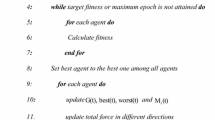Abstract
Aiming at the actual targets coverage scene of targets and sensors in the three-dimensional physical world, in order to use the minimal sensors to cover all the targets, a new coverage-all targets algorithm based on Gravitational Search algorithm (GSA-CT) is proposed. Firstly, from the practical point of view, a 3D coverage-all targets model of WMSNs which based on the spatial position relationship of sensors and targets is established in three-dimensional space. Secondly, in order to avoid randomness of the current order method to determine the minimal number of sensors to cover all the targets, a new fitness calculation method has been proposed. Thirdly, in order to improve solution accuracy, GSA is used as the optimization method of coverage-all targets method. Experimental results show that compared with the other 7 coverage methods for the 9 actual coverage scenarios, the number of sensors required for GSA-CT proposed in this paper is the least, and the method is very stable.











Similar content being viewed by others
REFERENCES
Demir, A.K., Demiray, H.E., and Baydere, S., QoSMOS: Cross-layer QoS architecture for wireless multimedia sensor networks, Wireless Networks, 2014, vol. 20, no. 4, pp. 655–670.
Chen, C.-C., Mukhopadhyay, S.C., Chuang, C.-L., et al., A hybrid memetic framework for coverage optimization in wireless sensor networks, IEEE Trans. Cybern., 2017, vol. 45, no. 10, pp. 2309–2322.
Zhou, Y., Xiang, W., and Wang, G., Frame loss concealment for multiview video transmission over wireless multimedia sensor networks, IEEE Sens. J., 2015, vol. 15, no. 3, pp. 1892–1901.
Lu, Y., Zhou, J., and Wan, L., C., Improved method for 2D target coverage in Wireless Sensor Networks, J. Xidian Univ., 2019, vol. 46, no. 2, pp. 101–106.
Sun, S., Sun, L., and Chen, S., Method of deployment and coverage for wireless sensor networks in three dimensional environment, J. Jilin Univ., 2016, vol. 54, no. 5, pp. 1109–1116.
Fan, X.G., Wang, H., and Hao, X., Algorithm for enhancing coverage ratio in directional sensor networks, Chin. J. Sci. Instrum., 2017, vol. 8, no. 2, pp. 368–377.
Tan, L., Wang, Y.H., Yang, M.H., et al., Three-dimensional space self-deployment algorithm based on virtual force compensation, Chin. J. Sci. Instrum., 2015, vol. 36, no. 11, pp. 2570–2578.
Ma, H., Zhang, X., and Ming, A., A coverage-enhancing method for 3D directional sensor networks, INFOCOM.IEEE, 2009, pp. 2791–2795.
Zhang, L.J. and Lin, F., Coverage strategy based on genetic algorithm for WSN, Commun. Technol., 2017, vol. 50, no. 5, pp. 962–967.
Manju, Chand, S., and Kumar, B., Target coverage heuristic based on learning automata in wireless sensor networks, IET Wireless Sens. Syst., 2018, vol. 8, no. 3, pp. 109–115.
Wang, Y.J., Bi, X.J., Teng, Z.J., et al., Coverage-all targets algorithm of directional sensor network for three-dimensional perception, J. Jilin Univ. (Eng. Technol. Ed.), 2015, vol. 45, no. 5, pp. 1671–1679.
Minárová, M., Paternain, D., Jurio, A., et al., Modifying the gravitational search algorithm: A functional study, Inf. Sci., 2018, vol. 430, no. 3, pp. 87–103.
Fan, Q., Wang, W., and Yan, X., Differential evolution algorithm with strategy adaptation and knowledge-based control parameters, Artif. Intell. Rev., 2017, vol. 51, no. 2, pp. 219–253.
Funding
This work was supported in part by the National Natural Science Foundation of China under grants no. 61501107, and the Education Department of Jilin province science and technology research project of “13th Five-Year” under grants [2016] no. 95. And the Project of Scientific and Technological Innovation Development of Jilin nos. 201750219 and 201750227.
Author information
Authors and Affiliations
Corresponding authors
Ethics declarations
The authors declare that they have no conflicts of interest.
About this article
Cite this article
Yanjiao Wang, Ye Chen Coverage-All Targets Algorithm for 3D Wireless Multimedia Sensor Networks Based on the Gravitational Search Algorithm. Aut. Control Comp. Sci. 53, 429–440 (2019). https://doi.org/10.3103/S0146411619050109
Received:
Revised:
Accepted:
Published:
Issue Date:
DOI: https://doi.org/10.3103/S0146411619050109




